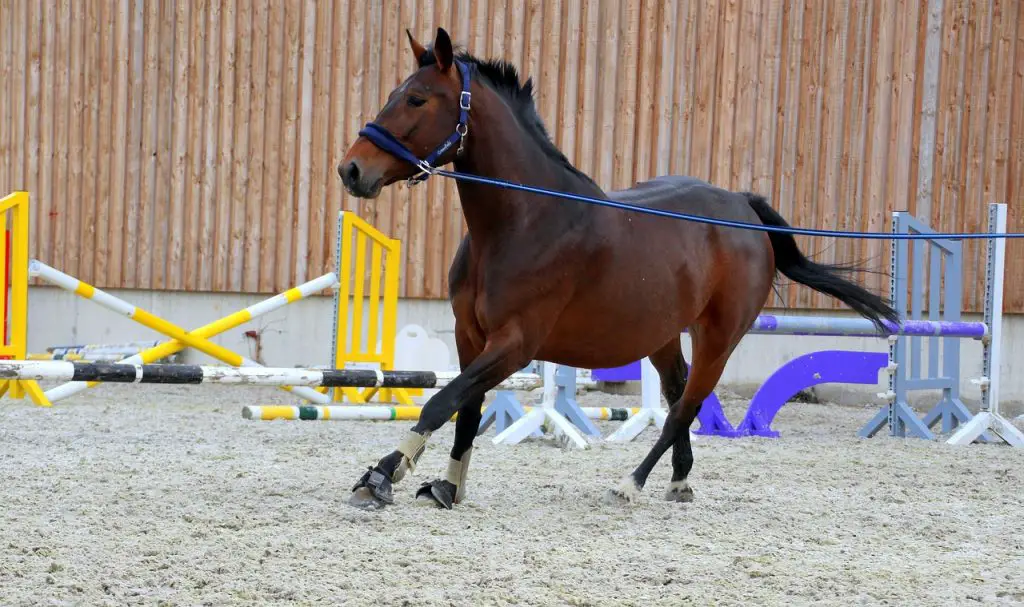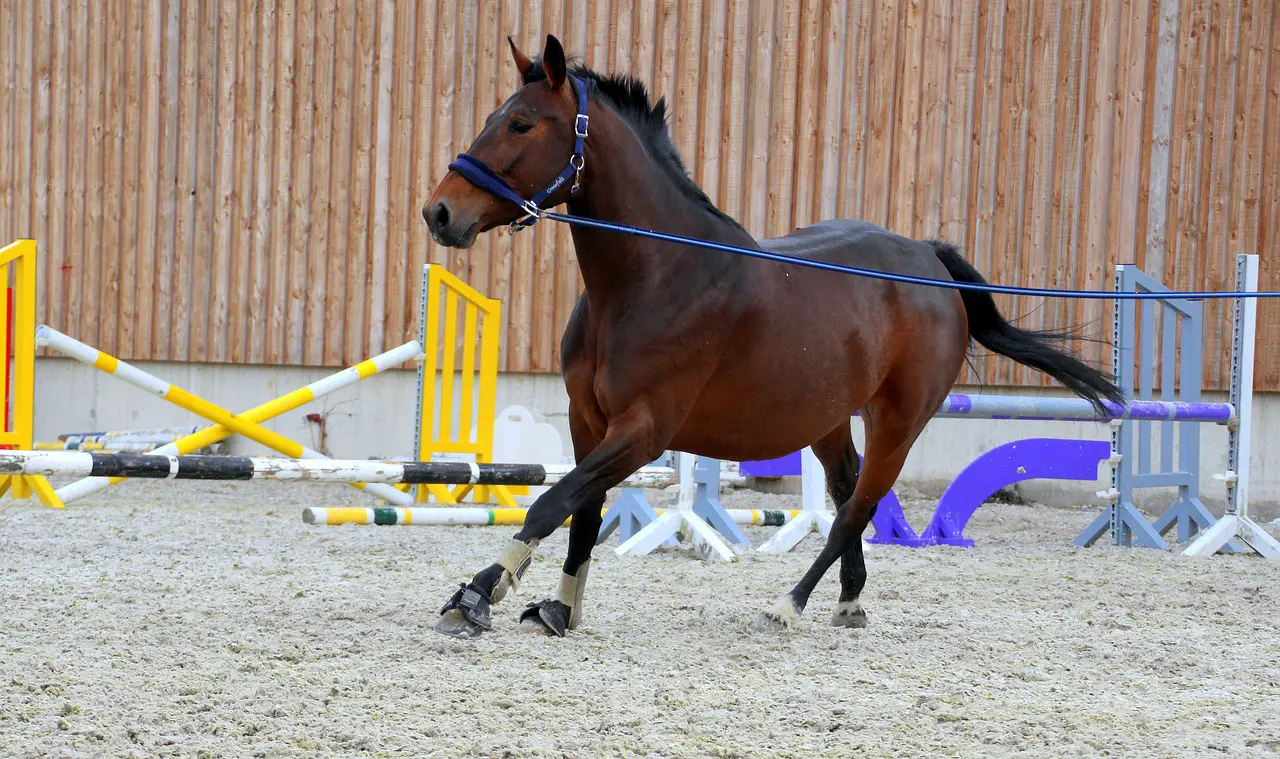Last Updated on February 22, 2022 by Allison Price
Horse lunging (or lungeing) can be a great way to have fun with your horse. It is also a great way to establish our roles while working with our horses.
Horse lunging involves the horse moving in a large circle. A handler uses a long rope and a whip to guide a horse. Verbal commands are also used. Lunging can be very helpful in settling horses with high strung horses and setting control.
It is easy to learn how to lunge a horse. Lunging can be dangerous if you make a few mistakes. Lunging is, first and foremost, a test of patience.
What does it mean to “lunge a mare”?
Most likely, you’ve heard of people who lunge their horses. What does this actually mean? You might mistakenly think that it is a huge leap if you don’t know much about equestrian terminology.

Lunging is a technique for horse training that emphasizes communication, stretching, and flexion. A horse must be able to balance and coordinate while luring him. It is also a good way to strengthen his hindquarters.
The French word alongier means “to extend, make long” and the word lunge is derived from it. A horse moves in a circle while its handler gives commands.
This exercise is best done in a round pen. It is a great tool for training your horse, but it can also be used for other purposes. The lunge line measures 7.6 m to 10.6 meter (25 to 35 feet).
For untrained horses, some trainers draw a circle on their ground while they lunge. Most horses can however follow an imaginary circle.
Lunging is done with a lunge whip (not to inflict pain), gentle pulls along the lunge line, voice commands and body gestures. This helps the horse cooperate fully with the handler.
The trainer will instruct the horse to move around the circle in a certain way. He/she will tell it to change its gaits, stop, change direction and maintain a balanced frame.
Horse lunging is one of the most rewarding and skillful activities that a trainer can perform. Learning how to properly lunge is essential to building a relationship with your horse.
Lunging with a horse is a great way to get your point across.
My grandson has an old horse with a cold back that bucks whenever you attempt to mount it. We saddle up, then work the horse on a lunge line for about a minute before mounting. This solves any bucking issues. There are many other benefits to lunging horses.
Let’s take a look at these benefits.
- Lunging can help settle excited horses
Lunging horses is common because it’s a way to “get the freshness out” or “to blow off steam”. After three to four days of riding a horse, they don’t always anticipate it. To get horses in the right mindset for riding, I find 5 minutes of lunging to be a great way to get them there.
Horses that have been kept in a cramped area or not been exercised for a while are more likely to be anxious when they try to ride.
A walking wheel can be used to warm your horse. A young filly is in training and comes out of her stall with a lot of energy. We saddle her up and attach her to a walking stick before she is mounted by the jockey.
Distracted horses can be dangerous due to their unpredictable behavior. It can also put you at risk of injury.
Before riding, calm the horse by luring them in a controlled manner.
- Lunging can be used to train
Young horses can be taught to speak by learning to lunge. Horses can be trained to lunge in every possible gait. Riders can also see the horse’s movements better and correct it with the whip.
Riders can help with bad behavior like bucking and rearing. Riders can help horses learn to relax while trotting and cantering, as well as to respond to their aids. You can actually make a horse that is lurching forward do anything you would expect, such as jump over obstacles or reverse direction.
Lunging can help the horse stretch forward and down, avoid walking crookedly and equally balance its left- and right-sides. It also helps develop its rhythm.
- Lunging can improve communication
Lunging allows you to communicate with your horse by not only listening to their voice but also allowing them to understand what you are saying. Horses are sensitive to your position. Things like moving your shoulders and lowering your head will determine how respect you have for your horse.
You can use your non-verbal and verbal assertiveness to instill stress situations on horses and teach them to remain calm and responsive.
- Lunging can help horses get used to riding equipment.
A cavesson can be used to lunge your horse, but you don’t need the saddle or bridle. To familiarize themselves with their horse’s weight, bit pressure, and feel of reins, riders can saddle up a horse to lunge.
- Lunging can be used to treat horses that are unable to ride.
Your doctor might recommend that you not ride your horse for several days if your horse has been injured or is ill. If your horse has suffered an injury or illness, you may be advised to stop riding for a few days. Lunging the horse is a good way to engage the horse and maintain your bond.
- Lunge lessons make horse-riding easier
Lunge riding lessons are a great option for inexperienced riders. A lunge lesson is when an instructor guides the horse through the lunge line. This allows novice riders to feel comfortable and can practice various movements without worrying about falling on the horse.
Are horses harmed by lunging?
If done properly, lunging a horse isn’t dangerous. If you don’t communicate well, aren’t patient or don’t communicate well, lunging can be dangerous.
Let’s take a look at the most common mistakes when lunging a horse.
- Too long
You shouldn’t lope your horse for longer than 30 minutes. Some horses can tolerate five minutes. Horses can over-lunge, which can lead to painful joint strain. Make sure they obey your commands and remember that lunging is a negative experience.
- Lunging without a whip
It is dangerous to lunge with a whip that is not longer than a normal whip. The whip is used to maintain the horse in the circle, to communicate your disapproval and to correct the horse’s form.
- Unnecessary equipment
You should not use horse tack unless you are trying to get your horse to accept a piece or equipment. Pulling too hard can cause excessive pain and may even prevent lateral bending.
Horses can also become tired from additional equipment that may add weight or pressure.
- Slumbering on an unsuitable ground
Horses should not be able to lunge on uneven ground, rocks, holes or steep surfaces. Horses can be playful when lunging and may slip or trip on uneven ground.
- Walking in a small circle
Horses can strain their muscles and joints by bouncing around in a circle less than 65 feet (20 m).
- Lacking basic lunging know-how
Basic knowledge of lunging is essential for horse people. It is important to keep the horse within a narrow circle and not to force it. It is important to have a confident and expressive body posture.
As with general horse training, it is important to not alter the sound of a command. You should also avoid whipping the horse as this can cause him to become more sensitive or agitated.
- Do not disregard personal precautions
Personal safety precautions for lunging include wearing gloves to prevent rope burns, keeping the lunge line from getting tangled in your feet or your horse’s feet, as well as staying clear of the “kickzone” of your horse.
How to lunge a horse.
- Boots and gloves
Gloves are necessary to avoid rope burns and maintain a firm grip on rope. Good boots will give you a solid stance. To protect your horse from falling or kicks, a helmet is a must.
- Lunging cavesson
Lunging cavesson a special headgear that is used to lunge a horse. It is made up of metal rings that attach the lunge line and a noseband. Sometimes, there are additional straps. It provides more control over lunging than a harness or halter and does not place pressure on the horse’s mouth.
- Lunge line
A lunge line refers to a long piece of rein that is attached to the cavesson. It is used to direct and instruct horses during lunging by applying pressure at certain times. It can be between 25 and 35 feet (7.6-10.6 meters) in length.
- Lunge whip
The lunge whip has a stock length of between 5 and 7 feet and a lash length of around 6 feet. It can be used as a riding leg or to just tickle the horse.
- A large lunging area
Horses should be able to lunge in large areas without obstacles. A lunging circle should measure approximately 65 feet (20 m) in diameter. Your horse’s ligaments could be put under stress if your lunging circle gets too small.
To ensure balance and avoid tripping, the ground must be level. To prevent slippage, the surface should not be slippery or muddy.
How to lunge a horse.
You have a horse that is eager to go, so you decide to lunge it. First, fit the cavesson. Next, attach the lunge rope. Grab the line with one hand, the lunge whip with your other and then put on your gloves.
Move your horse around in a small circle. Drop the line if your horse attempts to run away or becomes excited. You can use “whoa” as a signal to let them know they are wrong.
You can instruct the horse to move once more, but not too far from the center. To ask the horse to move further, you can hold your whip toward its shoulder. Continue to release the line until it is almost fully extended.
Always make use of your voice, whip, body cues, and lunge line. You can express yourself by simply holding your whip up or keeping it down. It’s important to pay attention and keep consistent the pitch, intensity and tone of any command, such as a long “sm-oo-oo-oo-oc-h” to indicate lope.
When your horse is able to move along the circle in a stable and balanced motion, you can give it the command for trot. Once your horse is comfortable trotting on command you can move to the canter.
No matter how fast your horse is progressing, don’t let him lunge for longer than 20-30 minutes. If your horse is not responding to your commands, stop it and begin again. Before giving a command, give the lunge line a gentle tug.
Next, teach your horse how to reverse the direction. It is important to work in both directions so that the horse doesn’t become fatigued.
You can reverse the direction by stepping back from where you are, so that your horse faces you. Then, switch your whip and lunge line. As your horse moves towards you and you step to the side, use your whip to direct it in a circular motion.
You can make certain sounds to express disapproval but praise your horse when it obeys your commands.
You now know that your horse can move in a different direction and change its gaits. It’s time for you to play around with things to help your horse focus. You can have your horse walk from a walk, change its direction mid-trot, or halt while it is looking at you.
It may take several weeks to teach your horse how to lunge if they are stubborn. It can take weeks to teach your horse to lunge. Be patient and build trust.


